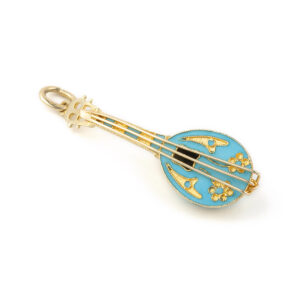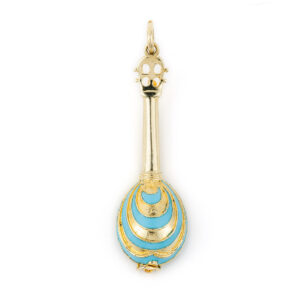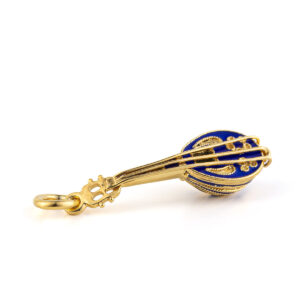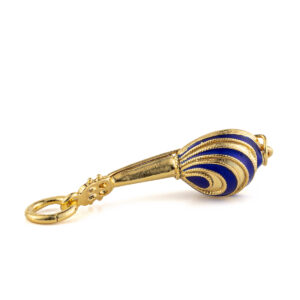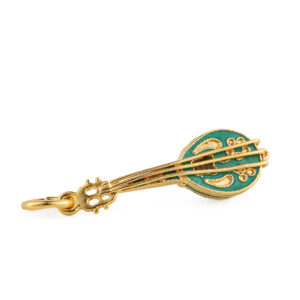Η αρχαία Ελλάδα ξαναζωντανεύει μέσα από τα κοσμήματα αυτής της συλλογής. Μύθοι, ιστορικά γεγονότα και πρόσωπα, μοναδικές αρχιτεκτονικές εμπνευσμένες από την Ελληνική κληρονομιά ζωντανεύουν μέσα από περίτεχνες τεχνικές της ελληνικής χρυσοχοΐας που κληρονομήσαμε από τους προγόνους μας.
Κολιέ με Μενταγιόν Μπουζούκι με Μπλε Σμάλτο – Ασήμι 925
Greek Bouzouki Charm with enamel. The pendant is decorated with rosette motifs.
Made of sterling silver.
Handmade item.
Design inspired by the Greek tradition.
Κολιέ με Μενταγιόν Μπουζούκι με Τυρκουάζ Σμάλτο
Greek Bouzouki Charm. The pendant is decorated with rosette motifs.
Made of sterling silver and gold plated.
Handmade item.
Design inspired by the Greek tradition.
Κολιέ με Μενταγιόν Μπουζούκι – Ασήμι 925
Greek Bouzouki Charm. The pendant is decorated with rosette motifs.
Made of sterling silver.
Handmade item.
Design inspired by the Greek tradition.
Κολιέ με Μενταγιόν Μπουζούκι – Ασήμι 925 Επιχρυσωμένο
Greek Bouzouki Charm. The pendant is decorated with rosette motifs.
Made of sterling silver and gold plated.
Handmade item.
Design inspired by the Greek tradition.
Κολιέ με Μενταγιόν Μπουζούκι με Μπλε Σμάλτο
Greek Bouzouki Charm with enamel. The pendant is decorated with rosette motifs.
Made of sterling silver and gold plated.
Handmade item.
Design inspired by the Greek tradition.
Κολιέ με Μενταγιόν Μπουζούκι με Πράσινο Σμάλτο
Greek Bouzouki Charm with enamel. The pendant is decorated with rosette motifs.
Made of sterling silver and gold plated.
Handmade item.
Design inspired by the Greek tradition.
14kt Yellow Gold Greek Bouzouki Charm Pendant
492,00€Made in 14k yellow gold.
Handmade in Greece.
Used as a charm or as a pendant.
Design inspired by the Greek tradition
Explore Heritage Collection
History
The Greek bouzouki is a plucked musical instrument of the lute family, called the thabouras or tambouras family. The tambouras existed in ancient Greece as the pandura, and can be found in various sizes and shapes. The bouzouki and the baglamas are the direct descendants. The bouzouki arrived in Greece following the 1919–1922 war in Asia Minor and the subsequent population exchange between Greece and Turkey. The early bouzoukia mostly had three courses. At the end of the 1950s, four-course (tetrachordo) bouzoukia started to gain popularity. The four-course bouzouki was made popular by Manolis Chiotis. Manolis Chiotis was a Greek rebetiko and laiko composer, singer, and bouzouki player. He is considered one of the greatest bouzouki soloists of all time.
Μενταγιόν Μπουζούκι – 14Κ Χρυσό
730,00€Greek Bouzouki Charm with turquoise enamel. The pendant is decorated with rosette motifs.
Made in 14k yellow gold.
Used as a charm or as a pendant.
Design inspired by the Greek tradition
The Greek bouzouki is a plucked musical instrument of the lute family, called the thabouras or tambouras family. The tambouras has existed in ancient Greece as pandoura, and can be found in various sizes and shapes. The bouzouki and the baglamas are the direct descendants. The bouzouki arrived in Greece following the 1919–1922 war in Asia Minor and the subsequent exchange of populations between Greece and Turkey when the ethnic Greeks fled to Greece. At the end of the 1950s, four-course (tetrachordo) bouzoukia started to gain popularity. The four-course bouzouki was made popular by Manolis Chiotis. Manolis Chiotis was a Greek rebetiko and laiko composer, singer, and bouzouki player. He is considered one of the greatest bouzouki soloists of all time. In the summer of 1961, he played for Aristotle Onassis and Maria Callas and Grace Kelly. Callas told Chiotis that she had been translating the lyrics of his songs to Princess Grace all night long and the American actress loved them because “she is a woman in love.” At that moment, Kelly asked Chiotis what the difference between a bouzouki and an electric guitar is. Chiotis’ answer was rather unexpected; “Mrs. Callas, please explain to Princess Grace that the strings of an electric guitar vibrate due to electricity, while the strings of a bouzouki vibrate through the heart.” *
The rosette (rose) is a timeless jewel, symbol and amulet. The origin of the term is the Greek word for rose – rodon (ρόδον). Its use began in the Mycenaean era and continues as far as the 2nd millennia BC. The Mycenaean Rosette is a motif that was widespread throughout Mesopotamia, Egypt, Greece and other ancient civilizations. Rosette or Rodax was probably the most popular and favorite decorative element in Mycenaean era, classical antiquity and Byzantine times.



